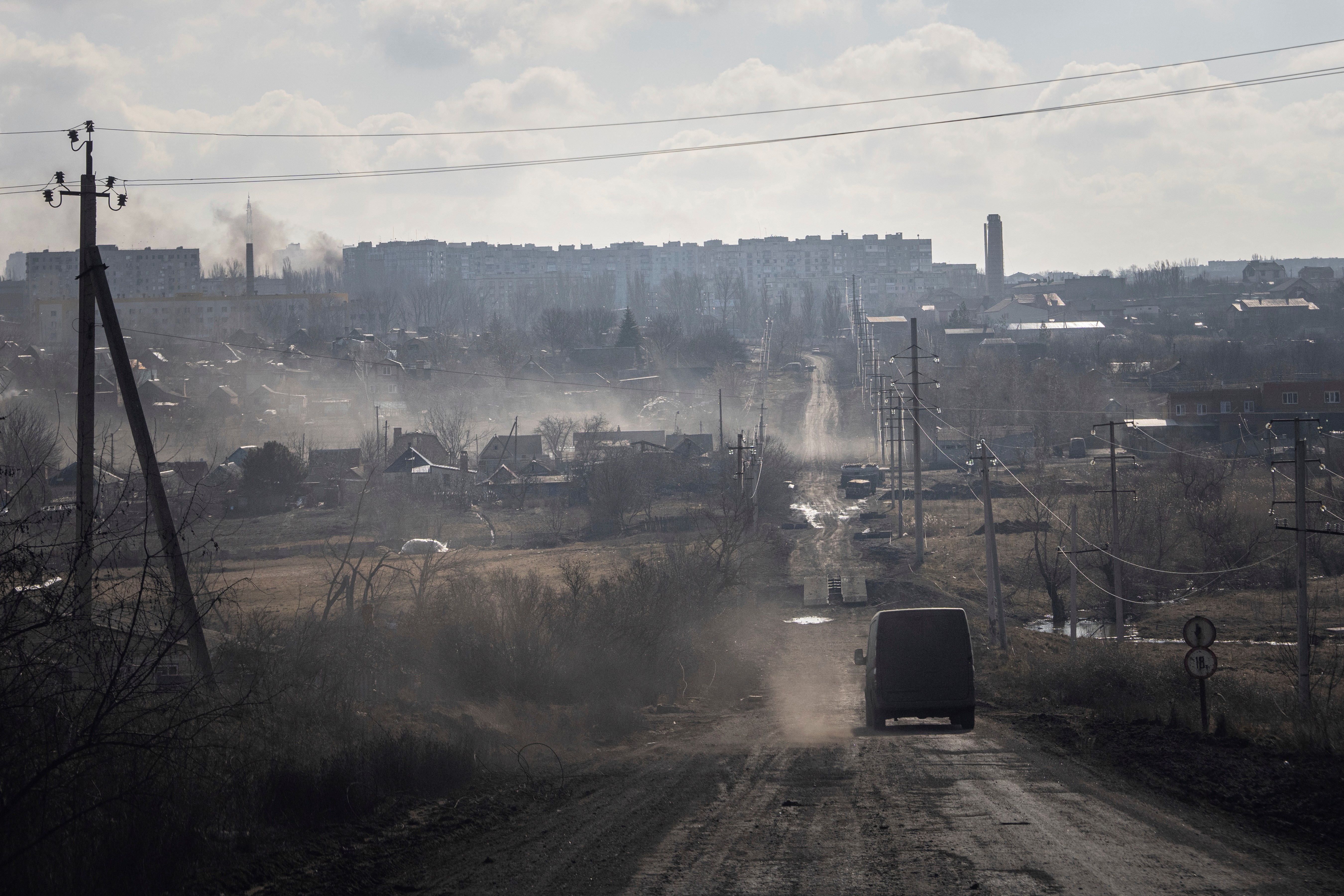Bakhmut nearly fully encircled by Russian forces - reports
Russia almost has the entirety of Bakhmut in its grip as the Ukrainian forces are pushed back and Moscow shells the routes out of the city.
-

A Ukrainian police van drives on the highway for evacuation civilians in Khromove near Bakhmut, Donetsk region, Saturday, March 4, 2023 (AP Photo/Evgeniy Maloletka)
The last routes out of Bakhmut were hit by Russia on Friday as Moscow seeks to complete its encirclement of the city that has been at the center of fierce battles for months now, putting Russia before a new major victory.
The city, according to the head of the Russian Wagner private military company, Yevgeny Prigozhin, is almost completely surrounded with only one route still open for Kiev's forces.
The UK Ministry of Defense stated earlier on Saturday that routes to besieged Bakhmut made the possibility of resupplying the Ukrainian Armed Forces "increasingly limited".
“The Ukrainian defense of the Donbas town of Bakhmut is under increasingly severe pressure, with intense fighting taking place in and around the city,” the MoD said.
🇷🇺⚔️🇺🇦Yevgeny Prigozhin, being with the fighters in the taken positions, receives up-to-date information about the movement of "Wagner", including the village of Khromove
— AZ 🛰🌏🌍🌎 (@AZgeopolitics) March 4, 2023
Soldier pointing to Khromove saying" is returning[probably AFU retreating]" pic.twitter.com/7qVF0LTZFz
The MoD highlighted that "within the last 36 hours two key bridges in Bakhmut have been destroyed, including a vital bridge connecting the city to the last main supply route from Bakhmut to the city of Chasiv Yar."
However, the Russian forces have also made additional gains and have advanced "into the northern suburbs of the city, which is now a Ukrainian-held salient, vulnerable to Russian attacks on three sides."
Wagner aviation hit Bahmut pic.twitter.com/iOZ78R9FAc
— ZOKA (@200_zoka) March 4, 2023
Reuters news agency reported that there was heavy shelling from the Russian side aimed at blocking the Ukrainians from leaving and entering the city, thus preventing them from both withdrawing and receiving backup.
Reportedly, ahead of the Russian shelling, Ukrainian soldiers were working on preparing the damaged roads, with troops heading toward the frontline to bolster Kiev's positions as other troops were digging new trenches for defensive positions in the West.
⚡️Wagner artillery working in the Bakhmut direction, reportedly today.
— War Monitor (@WarMonitors) March 4, 2023
Urgent geo needed. pic.twitter.com/2TJL71XYuH
The Russian RIA Novosti news agency released footage showing Wagner fighters passing by a damaged facility, and one fighter was heard saying Kiev's forces were destroying infrastructures in settlements near the city in order to prevent Russian encirclement.
An adviser to the head of the Donetsk People's Republic, Igor Kimakovsky, said in late February that soldiers for the Ukrainian armed forces blew up a dam near Bakhmut, also known as Artyomovsk, in a bid to slow down the Russian offensive and force civilians to leave the besieged city.
"The dam was blown up, and the resulting torrent of water flowed toward Artyomovsk. They are likely trying to halt our offensive. Maybe they want to try and cut off our assault units from the rear to slow down munition supply," Kimakovsky told Russian news agency Sputnik.
According to the advisor, the move could also mean that Ukrainians were preparing to abandon the city to the Russian forces and were getting "desperate."
"They told civilians to evacuate… Their goal is to make living conditions unbearable. They do not care about the people; they only care about destroying the city so that it would be economically unfeasible for us to rebuild," Denis Pushilin's advisor added.
Bakhmut is "a slaughterhouse on both sides," said the commander of the Ukrainian army unit at Bakhmut, Denys Yaoslavski, during an interview with Espreso TV, adding that some units had been ordered to rotate to more secured positions.
This comes after a US mercenary fighting on the frontlines against the Russian armed forces said the Bakhmut frontlines were highly gruesome, comparing it to a meat grinder, as Russia pushes against Kiev's forces in the city for which battles have been taking place for months.
"Units of the private military company Wagner have practically surrounded Bakhmut," Prigozhin said. "Only one route is left [...] the pincers are closing."
The Wagner chief called on Ukrainian President Volodymyr Zelensky during a video to order a retreat from Bakhmut, also known as Artyomovsk, in a bid to save his soldiers' lives. The video then showed three captured soldiers asking to be allowed to go back home.
A US mercenary fighting on the frontlines against the Russian armed forces said, late in February, the Bakhmut frontlines were highly gruesome, comparing the front to a meat grinder, as Russia pushes against Ukraine's forces in the city for which battles have been taking place for months.
Former US Marine Troy Offenbecker underlined to ABC News that the life expectancy of Ukrainian soldiers on the city's frontlines was only about four hours, with a major offensive still expected from Russia.
"It's been pretty bad on the ground," he told the US network. "A lot of casualties. The life expectancy is around four hours on the frontline."
Offenbecker underlined that he was not sure how long Kiev's forces would be able to hold the city, adding that the expected offensive had already kicked off and that attacks from Russians have been "nonstop" in Bakhmut, with artillery raining down upon it "all day and night".
The commander of a Ukrainian drone unit in Bakhmut, Robert Brovdi, came out and said his unit had been ordered to withdraw immediately, saying he had been fighting there for nearly four months.
Documents obtained by Politico show that the EU has been supplying Ukraine with arms through an off-budget, inter-government cash pot called the European Peace Facility, which aims to "repay" countries that sent arms to Ukraine. It has so far paid Ukraine €3.6 billion in military aid to Ukraine, with member states deciding to increase its funding by €2 billion in 2023.
The documents suggest that €1 billion should be focused on ammunition, notably 15mm, as soon as the €2 billion top-up of the European Peace Facility is “operationalized.” According to an EU official, this means that half of the year's top-up should be for ammunition, mainly shells.
The document also anticipated the increase in European industrial production, which is straining to produce ammunition at the rate demanded by the war.

 6 Min Read
6 Min Read











